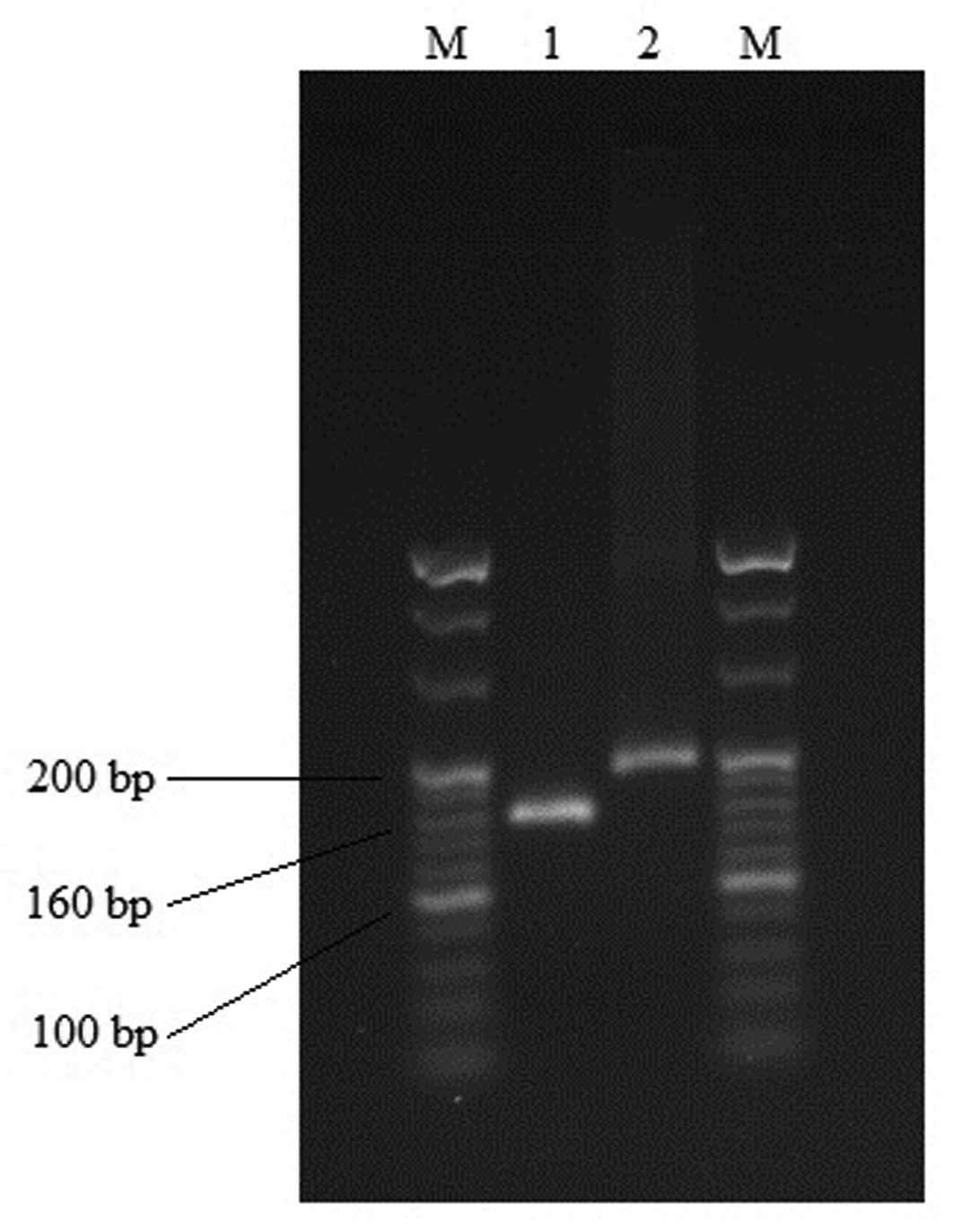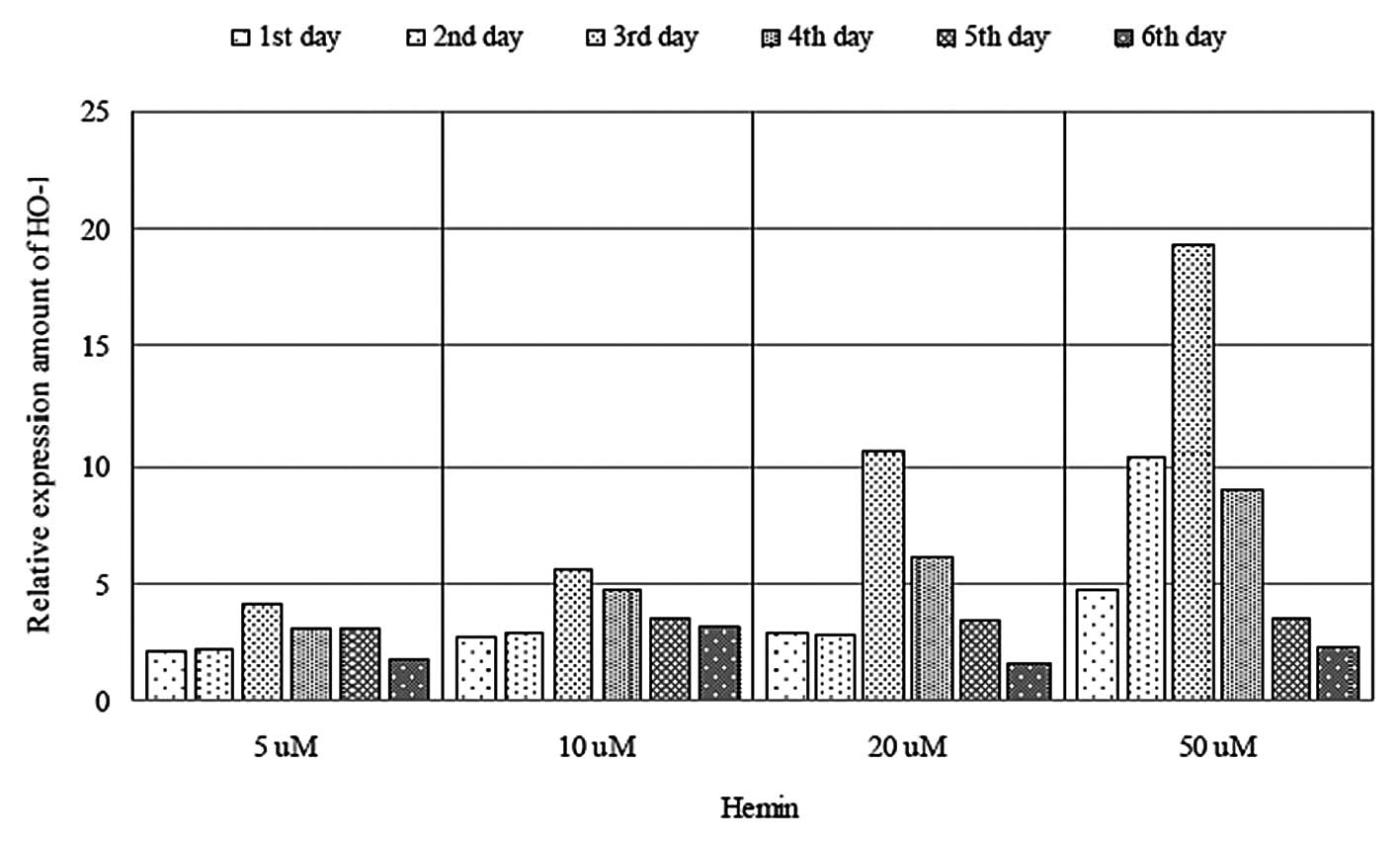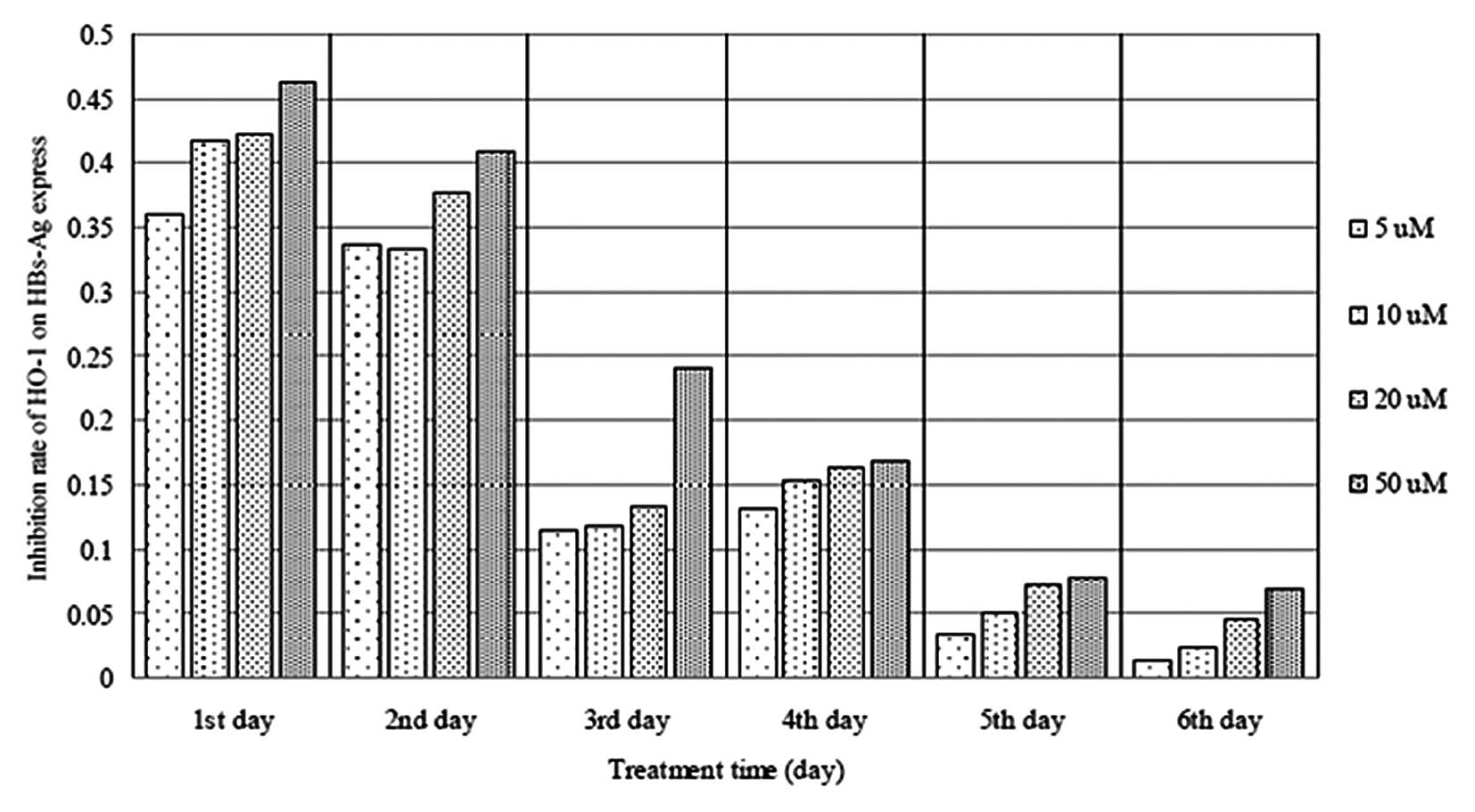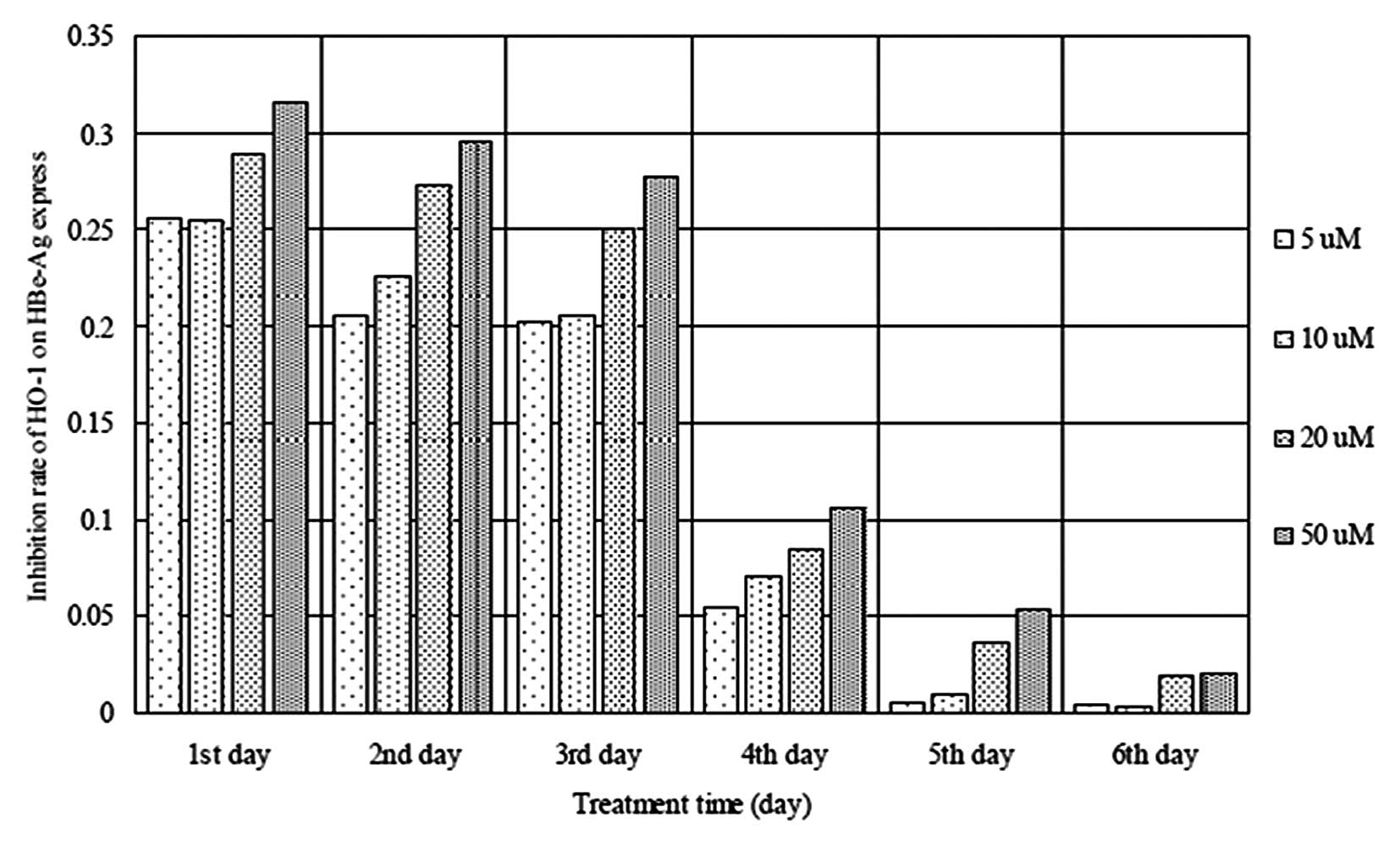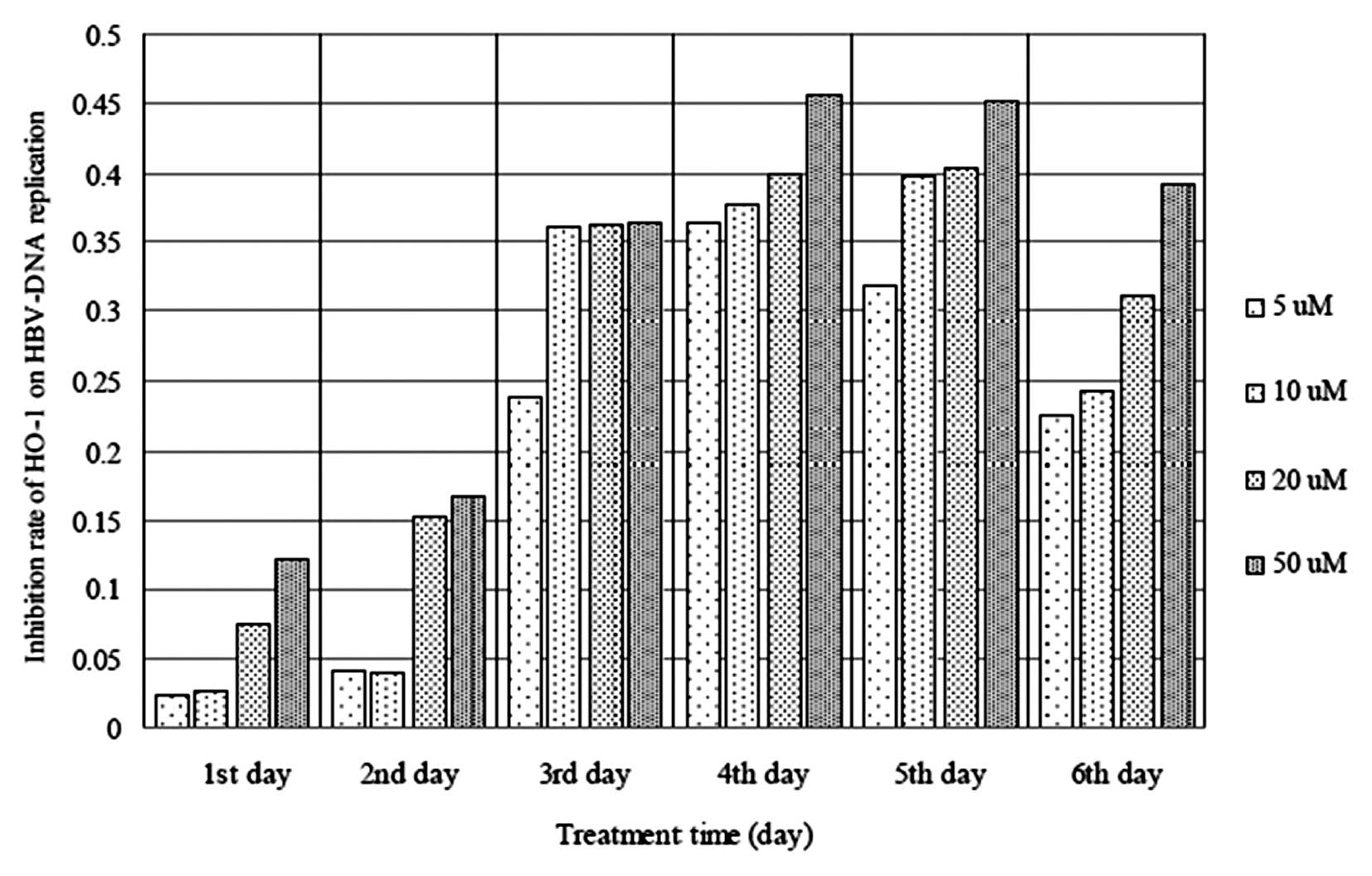Dynamic correlation between induction of the expression of heme oxygenase-1 and hepatitis B viral replication
- Authors:
- Published online on: January 29, 2015 https://doi.org/10.3892/mmr.2015.3278
- Pages: 4706-4712
Abstract
Introduction
Hepatitis B is the most common severe hepatic infection worldwide. The causative agent of hepatitis B is the hepatitis B virus (HBV), which attacks the liver. There is currently no complete cure for chronic hepatitis B. The drugs currently used to treat hepatitis B slow the progression of liver disease, by suppressing the virus. If less HBV is produced, less liver damage occurs (1). However, the current anti-HBV drugs, including interferon-α and nucleoside analogues, have certain disadvantages, including the rebound phenomenon of HBV replication following withdrawal of treatment and unpleasant side effects (2). Furthermore, a significant number of patients develop drug resistance following long-term use of these therapeutic agents (3). Therefore, further investigation is required, in order to develop novel anti-HBV agents.
Heme oxygenases (HO) are rate-limiting enzymes in heme catabolism. They catalyze the oxidative degradation of heme to carbon monoxide, free iron and biliverdin, which is subsequently converted to bilirubin by the bilirubin reductase enzyme (4,5). Among the three known heme oxygenase isoforms, HO-1, HO-2 and HO-3; HO-1 is the only inducible form present in almost every type of cell (6). The induction, overexpression or inhibition of HO-1 degradation has been observed to interfere with acute and chronic liver inflammation and fibrotic progression, apoptotic liver damage, replication of hepatitis B and C viruses or protection of liver grafts from ischemia/reperfusion injury, caused by either transplantation or hemorrhage/resuscitation (7). Therefore, HO-1 possesses significant curative potential, particularly for patients with hepatitis B and C, predominantly due to its anti-inflammatory, anti-apoptotic, antifibrotic and antiviral properties (7).
The induction of HO-1 directly represses HBV replication in hepatocytes at the post-transcriptional level by reducing the stability of the HBV core protein, therefore inhibiting the refill of nuclear HBV covalently closed circular DNA (HBV cccDNA) (8). Small interfering (si)RNA, directed against HO-1 demonstrated that this effect is dependent on the expression of HO-1 (7). Therefore, the induction of HO-1 may be a novel therapeutic option for hepatitis B-associated inflammation. Although HO-1 has been observed to exhibit pronounced antiviral properties, the dynamic association between HBV replication and the expression of HO-1 remains to be elucidated. The present study aimed to investigate the overexpression of HO-1 induced by hemin, and to discuss the dynamic association between HBV replication and the induction of HO-1 in HBV-transfected HepG2.2.15 cells.
Materials and methods
Reagents
Fetal bovine serum, hemin and Dulbecco’s modified Eagle’s medium (DMEM) were purchased from Gibco Life Technologies (Grand Island, NY, USA). 3-(4,5-dimethylthiazol-2-yl)-2,5-diphenyltetrazolium bromide (MTT) was purchased from Sigma-Aldrich (St. Louis, MO, USA). A HBV DNA polymerase chain reaction (PCR)-fluorescence quantitation kit and enzyme-immunoassay (EIA) kits for the detection of hepatitis B surface antigen (HBsAg) and hepatitis B e antigen (HBeAg) were obtained from Shanghai Kehua Bio-engineering Co., Ltd (Shanghai, China). G418 was purchased from Invitrogen Life Technologies (Carlsbad, CA, USA). SYBR® Premix Ex Taq™, RNAiso Plus, a Prime Script Reverse Transcription (RT) Reagent kit and DNA ladder marker were obtained from Takara Biotechnology Co., Ltd. (Dalian, China). All other reagents were of the highest commercial grade available.
Cytotoxicity of hemin on HepG2.2.15 cells
HBV-transfected HepG2.2.15 hepatoma cells (5.0×104 cells/ml) were provided by the State Key Laboratory for Diagnosis and Treatment of Infectious Diseases at Zhejiang University (Zhejiang, China) (9) and maintained in DMEM supplemented with 2 mM glutamine, 10% (v/v) heat-inactivated fetal bovine serum and 380 μg/ml G418 at 37°C in a 95% humidified atmosphere containing 5% CO2. Hemin-induced cytotoxicity was analyzed using an MTT assay. Briefly, the cells were seeded in a 96-well plate (5.0×104 cells/ml; 200 μl/well). Different concentrations of hemin (5, 10, 20, 50, 75 and 100 μM) were applied to the culture wells in triplicate. The cells were then incubated for six days and 10 μl MTT (5 mg/ml) was then added to the cells in each well. Following 4 h culture at 37°C (95% humidity; 5% CO2), the medium was removed, and the blue formazan crystals, which had formed, were dissolved in 150 μl dimethyl sulfoxide (Sigma-Aldrich). The absorbance of the formazan generated from MTT was measured at a wavelength of 570 nm using a Multi-Well microplate reader (Multiskan MK3; Thermo Fisher Scientific Inc., Waltham, MA, USA). The cytotoxicity of hemin was defined according to the quantity of formazan produced relative to that produced by the untreated cells, and was expressed as cell viability.
Hemin-induced expression of HO-1 in HepG2.2.15 cells
HepG2.2.15 cells were seeded in six-well plates (5.0×104 cells/ml) and were treated with various concentrations of hemin (5, 10, 20 and 50 μM) for 1–6 days, respectively. The mRNA expression of HO-1 was detected using quantitative (q)PCR. Total RNA was extracted from the HepG2.2.15 cells using RNAiso Plus reagent, followed by recombinant DNase I (RNase-free; Takara Biotechnology Co., Ltd) digestion. The RNA was reverse transcribed into cDNA using the Prime Script RT reagent kit, according to the manufacturer’s instructions. The products of reverse transcription served as a template for qPCR. qPCR was performed with SYBR Premix Ex Taq (Tli RNaseH Plus) using a Bio-Rad iQ5 Real Time PCR system (Bio-Rad Laboratories, Inc., Hercules, CA, USA). β-actin was used as an internal control. The primers for HO-1 and β-actin were specifically designed according to the mRNA sequences of human HO-1 and β-actin, obtained from Genbank (http://blast.st-va.ncbi.nlm.nih.gov/Blast.cgi?CMD=Web&PAGE_TYPE=BlastHome). The following primer sequences were used: HO-1, forward 5′-TTGCCAGTGCCACCAAGTTC-3′, reverse 5′-TCAGCAGCTCCTGCAACTCC-3′; and β-actin, forward 5′-TGGCACCCAGCACAATGAA-3′, and reverse 5′-CTAAGTCATAGTCCGCCTAGAAGCA-3′. The thermal program comprised of an initial denaturation at 95°C for 30 sec, followed by 40 amplification cycles, each containing two steps: 95°C for 5 sec and 60°C for 1 min. The target gene fragments were analyzed using gel electrophoresis (2% agarose; Biowest SAS, Nuaillé, France), to verify the specificity of the primers. To check the purity of the products, a melting curve analysis was performed after each run. Relative quantification was conducted using the cycle threshold (Ct) values, which were determined for triplicate reactions for the assessed and reference samples for each target gene, and for the internal control gene (β-actin). The relative expression levels were determined using the 2−ΔΔCt quantification method, where ΔΔCt = ΔCt(target sample) - ΔCt(reference sample) (10).
HBV replication in HepG2.2.15 cells treated with hemin
The medium, in which the HepG2.2.15 cells treated with hemin for 1–6 days, was used to measure the HBsAg, HBeAg and HBV DNA levels. The levels of HBsAg and HBeAg in the culture supernatants were determined using EIA kits, according to the manufacturer’s instructions. The absorbance was measured at 450 nm using a multi-well plate reader. The HBV viral load in the culture supernatants was detected using a HBV DNA PCR-fluorescence quantitation kit. Briefly, viral DNA from HBV virions present in the cell culture supernatants was extracted and amplified using the Bio-Rad iQ5 Real Time PCR system. The primer sequences were as follows: Forward 5′-CCGTCTGTGCCTTCTCATCTG-3′, and reverse 5′-AGTCCAAGAGTACTCTTATAGAAGACCTT-3′. The Taqman probe sequence was: FAM-CCGTGTGCACTTCGCTTCACCTCTGC. The thermal program comprised of an initial denaturation at 94°C for 2 min, followed by 40 amplification cycles each containing two steps: 95°C for 5 sec and 60°C for 30 sec. A plasmid containing the HBV genome was used to prepare the standard curve.
Dynamic correlation between HO-1 induction and HBV replication
Preliminary investigations indicated that 50 μM hemin is the maximum non-toxic concentration on HepG2.2.15 cells, and is the optimal concentration for the induction of HO-1 (Table I). To further determine the dynamic correlation between the induction of HO-1 and the replication of HBV, overexpression of HO-1 was induced using 50 μM hemin, and its effects on HBV replication were investigated in the HepG2.2.15 cells. HepG2.2.15 cells were treated with 50 μM hemin for 1–6 days. The expression levels of HO-1 in the cells treated with hemin for different durations were determined using qPCR, as described above. The HBsAg and HBeAg levels in the culture supernatants were determined using EIA kits. The HBV viral load the in culture supernatants were detected using a HBV DNA PCR-fluorescence quantitation kit.
Statistical analysis
The experimental data are expressed as the mean ± standard deviation. The results were subjected to one-way analysis of variance and Student’s t-test in order to determine significance. Statistical analyses were performed using SPSS 10.0 software (SPSS, Inc., Chicago, IL, USA). P<0.05 was considered to indicate a statistically significant difference.
Results
Cytotoxicity analysis of hemin
The cytotoxicity of hemin on HepG2.2.15 cells was determined using an MTT assay. Hemin was non-toxic to the cells when used at a concentration between 5 and 50 μM for six days (Table I). Following exposure to 50 μM hemin for six days, cell viability was 91.17%. The maximum non-toxic concentration of hemin on HepG2.2.15 cells was 50 μM, whereas treatment with hemin at concentrations between 75 and 100 μM produced a significant decrease in cell viability. Cell viability was 86.82 and 79.38% following exposure to 75 and 100 μM hemin for six days, respectively.
Hemin induces the expression of HO-1
The mRNA expression levels of hemin-induced HO-1 were determined in the HepG2.2.15 cells by qPCR (Fig. 1). Treatment with hemin at 5–50 μM significantly increased the expression levels of HO-1 in a dose-dependent manner. Exposure of the cells to hemin for different durations resulted in an elevation in the mRNA expression levels of HO-1 (Fig. 2). Furthermore, the mRNA expression of HO-1 peaked following exposure to 5–50 μM hemin for three days, whereas the mRNA expression levels began to decrease as the duration of exposure to hemin increased further.
Effects of hemin on HBV replication
The levels of HBsAg and HBeAg were detected in the HepG2.2.15 cell culture supernatants following incubation with hemin (5–50 μM) for 1–6 days. The expression of HBsAg was significantly inhibited in the HepG2.2.15 cells following exposure to 5–50 μM hemin (Fig. 3). In addition, the expression of HBeAg was markedly reduced in the cells following exposure to 5–50 μM hemin (Fig. 4). Furthermore, as the duration of exposure to hemin, increased, the inhibitory trend was less marked. The DNA expression levels of HBV were determined in the culture supernatants following treatment of the cells with hemin (5–50 μM) for 1–6 days. HBV DNA replication was markedly inhibited following exposure to hemin, and this trend of inhibition became more marked as the duration of exposure increased (Fig. 5).
Correlation between the expression of HO-1 and HBV replication
To further analyze the dynamic association between the induction of HO-1 and HBV replication, the expression of HO-1 was induced in HepG2.2.15 cells with hemin, at an optimal concentration of 50 μM, for 1–6 days (Table II). The expression of HO-1 increased markedly following exposure of the cells to hemin for 1–6 days. The mRNA expression levels of HO-1 reached a peak in the hepatoma cells on the third day and subsequently reduced as the duration of exposure to hemin increased. Furthermore, the levels of HBsAg and HBeAg in the culture supernatants were significantly reduced following exposure to hemin for 1–6 days. The maximum inhibition of HBsAg and HBeAg was 37.37 and 31.73% on the first day, respectively; whereas inhibition of the expression levels of HBsAg and HBeAg decreased with increasing duration of exposure to hemin. By contrast, as the duration of hemin exposure increased, the inhibition of HBV DNA replication increased. Furthermore, the expression levels of HBV DNA were markedly reduced following exposure to hemin for 3–6 days, and reached their lowest levels on the fourth day.
Discussion
The HO system includes the heme catabolic pathway, which is comprised of HO and biliverdin reductase and the products of heme degradation, carbon monoxide, iron and biliverdin/bilirubin (11,12). As a protective enzyme, the relevance of HO-1 in humans and animals has been demonstrated in the case of HO-1 deficiency, which results in severe tissue damage due to oxidative stress and in multiple consecutive disorders (13–15). HO-1 and the reaction products of heme degradation have been associated with cytoprotection, due to their anti-inflammatory, antioxidative, and anti-apoptotic effects (8,16). Furthermore, the induction of HO-1 or application of its products has been observed to lead to a broad range of hepatoprotective effects in animal models of acute and chronic hepatitis (7). The effects of HO-1 include preventing and attenuating liver injury (17–22), protecting from liver fibrosis (23), interrupting the progression of nutritional steatohepatitis (24,25), preserving hepatic architecture (26), improving liver function (26,27) and providing protection against severe ischemia/reperfusion injury (27–30). Therefore, HO-1 offers a promising novel target in drug development, and the implementation of clinical approaches to moderate and alleviate the numerous chronic disorders affected by perturbations in the HO system (31).
It has been demonstrated that the induction or overexpression of HO-1 interfered with the viral replication of hepatitis B and C (8,32–35). HO-1 induction results in a marked antiviral effect in the adenoviral transfer of the HBV 1.3 genome into wild type mice and HBV transgenic animal models of acute and chronic HBV infection, respectively (8). Investigation into the effects of HO-1 on HBV replication in hepatoma cells stably transfected with HBV have revealed that induction of HO-1 directly suppressed HBV replication in hepatocytes at the posttranscriptional level by reducing the stability of the HBV core protein, inhibiting the refill of nuclear HBV cccDNA (8). Furthermore, it has been reported that microRNA-122, which is abundantly expressed in the human liver, interferes with the expression of HO-1, thereby promoting HBV replication (32,36). Conversely, HO-1 is overexpressed in various types of tumor, including hepatocellular carcinoma, and inhibiting the expression or activity of HO-1 promotes the apoptosis of cancer cells (37–39). Although its anti-apoptotic property risks the promotion of tumor growth (7), the induction of HO-1 may become a useful adjuvant for the clinical therapy of viral hepatitis.
HepG2.2.15 cells were initially derived from the HepG2 human hepatoblastoma cells, which were transfected with a plasmid containing HBV DNA. These transfected cells can stably secrete viral particles into culture medium (40). This in vitro system can be used to investigate the life cycle of HBV, and the reaction of immunocompetent cells to those containing HBV DNA (9). The present study investigated the dynamic correlation between the expression of HO-1 and HBV replication in HepG2.2.15 cells following exposure to various concentrations of hemin for 1–6 days. The initial comparative investigation of HO-1 expression levels following exposure to different concentrations of hemin demonstrated that hemin (5–50 μM) significantly induced the expression of HO-1. The mRNA expression levels of HO-1 increased in a dose-dependent manner and reached a peak following exposure to hemin for 3 days. However, the expression levels of HO-1 decreased with further extension of the duration of exposure to hemin, possibly due to the functions of HO-1 as a stress-responsive enzyme (41). The present study also investigated the levels of HBsAg and HBeAg following exposure to various concentrations of hemin. The results demonstrated that the expression levels of HBsAg and HBeAg were markedly inhibited following exposure to hemin for 1–6 days. Measurement of expression of HBV DNA following exposure to various concentrations of hemin demonstrated that HBV DNA replication was significantly inhibited in a time-dependent manner. These data suggested that the secretion of HBsAg/HBeAg and HBV DNA replication were inhibited with increasing expression levels of HO-1. Furthermore, as the duration of hemin exposure increased the inhibition of HBV DNA replication was more marked, implying that the reduction of HBV replication may contribute to the induction of the HO-1 gene.
To further understand the correlation between the induction of HO-1 and HBV replication, the gene expression of HO-1 was induced in HepG2.2.15 cells by hemin at the optimal concentration of 50 μM for 1–6 days. The significant elevation in the mRNA expression of HO-1 peaked on the fourth day, and subsequently reduced with further extension of the duration of exposure to hemin. Furthermore, the HBsAg and HBeAg levels in the cell culture supernatants were significantly reduced following exposure to hemin for 1–6 days. This marked reduction in the expression of HBsAg and HBeAg peaked on the first day, and the inhibition was weakened as the duration of exposure to hemin increased. Conversely, the inhibition of HBV DNA replication increased with increasing duration of exposure. Furthermore, DNA expression levels of HBV were significantly decreased following exposure to hemin for 3–6 days. The effects of hemin-induced HO-1 on HBsAg and HBeAg were different from those on HBV DNA. This may be associated with a non-significant correlation between either HBsAg or HBeAg levels, and HBV DNA levels (40,42). The present study demonstrated that the marked upregulation in the expression of HO-1 following treatment with hemin attenuated HBV replication in the HepG2.2.15 cells, indicating that pharmacologically inducing overexpression of HO-1 may provide protection against HBV infection. Furthermore, the downregulation of HBV replication in the cells may be associated with the reaction products of heme degradation and the inhibition of HBV reverse transcriptase (RT)-ε RNA interaction by hemin (7,43). HBV-RT has numerous roles in the viral life cycle and is an essential target for the development of anti-HBV chemotherapy; hemin was found to block RT interactions with viral RNA packaging signal/origin of replication ε, therefore suppressing the protein-priming reaction (43). Although the induction or overexpression of HO-1 may assist as an adjuvant for clinical therapy, no specific HO-1 inducers are currently available, despite attempts, including the use of miR-196 or antagomiR-122, direct silencing of the HO-1 transcriptional repressor Bach-1 by siRNA and the use of HO-1 coupled to a protein transduction domain (7). HO-1 and its products possess a significant curative potential that may assist in the treatment of patients with hepatitis.
In conclusion, the present study clarified the dynamic correlation between the hemin-induced expression of HO-1 and HBV replication in HepG2.2.15 cells. The upregulation of HO-1 interfered with HBV replication in a dose- and time-dependent manner. The secretion of HBsAg and HBeAg, and HBV DNA replication were inhibited with induction of the expression of HO-1, suggesting that a reduction in the HBV viral load may be contributed to by overexpression of HO-1.
Acknowledgments
The present study was supported by the Zhejiang Provincial Natural Science Foundation of China (grant no. Y14H310024), the Key Project of Chinese Ministry of Education (grant no. 212073) and the Public Welfare Technology Applied Research Project of Zhejiang Province-Experimental Animal Science and Technology Project (grant no. 2013C37020). The authors are grateful to Professor Hangping Yao (State Key Laboratory for Diagnosis and Treatment of Infectious Diseases at Zhejiang University) for kindly providing the HepG2.2.15 cells.
References
|
Hollinger FB and Liang TJ: Hepatitis B virus. Fields Virology. Knipe DM and Howley PM: Lippincott Williams & Wilkins; Philadelphia: pp. 2971–3036. 2001 | |
|
Wu YH, Hao BJ, Cao HC, Xu W, Li YJ and Li LJ: Anti-hepatitis B virus effect and possible mechanism of action of 3,4-o-dicaffeoylquinic acid in vitro and in vivo. Evid Based Complement Alternat Med. 2012:3568062012. View Article : Google Scholar : PubMed/NCBI | |
|
Delaney WE IV, Locarnini S and Shaw T: Resistance of hepatitis B virus to antiviral drugs: current aspects and directions for future investigation. Antivir Chem Chemother. 12:1–35. 2001. View Article : Google Scholar : PubMed/NCBI | |
|
Maines MD, Trakshel GM and Kutty RK: Characterization of two constitutive forms of rat liver microsomal heme oxygenase. Only one molecular species of the enzyme is inducible. J Biol Chem. 261:411–419. 1986.PubMed/NCBI | |
|
Maines MD: Heme oxygenase: function, multiplicity, regulatory mechanisms, and clinical applications. FASEB J. 2:2557–2568. 1988.PubMed/NCBI | |
|
Otterbein LE and Choi AM: Heme oxygenase: colors of defense against cellular stress. Am J Physiol Lung Cell Mol Physiol. 279:L1029–L1037. 2000.PubMed/NCBI | |
|
Sass G, Barikbin R and Tiegs G: The multiple functions of heme oxygenase-1 in the liver. Z Gastroenterol. 50:34–40. 2012. View Article : Google Scholar : PubMed/NCBI | |
|
Protzer U, Seyfried S, Quasdorff M, et al: Antiviral activity and hepatoprotection by heme oxygenase-1 in hepatitis B virus infection. Gastroenterology. 133:1156–1165. 2007. View Article : Google Scholar : PubMed/NCBI | |
|
Sells MA, Chen ML and Acs G: Production of hepatitis B virus particles in Hep G2 cells transfected with cloned hepatitis B virus DNA. Proc Natl Acad Sci USA. 84:1005–1009. 1987. View Article : Google Scholar : PubMed/NCBI | |
|
Livak KJ and Schmittgen TD: Analysis of relative gene expression data using real-time quantitative PCR and the 2(−delta delta C(T)) method. Methods. 25:402–408. 2001. View Article : Google Scholar | |
|
Tenhunen R, Marver HS and Schmid R: The enzymatic conversion of heme to bilirubin by microsomal heme oxygenase. Proc Natl Acad Sci USA. 61:748–755. 1968. View Article : Google Scholar : PubMed/NCBI | |
|
Tenhunen R, Marver H, Pimstone NR, Trager WF, Cooper DY and Schmid R: Enzymatic degradation of heme. Oxygenative cleavage requiring cytochrome P-450. Biochemistry. 11:1716–1720. 1972. View Article : Google Scholar : PubMed/NCBI | |
|
Yachie A, Niida Y, Wada T, Igarashi N, Kaneda H, Toma T, Ohta K, Kasahara Y and Koizumi S: Oxidative stress causes enhanced endothelial cell injury in human heme oxygenase-1 deficiency. J Clin Invest. 103:129–135. 1999. View Article : Google Scholar : PubMed/NCBI | |
|
Kawashima A, Oda Y, Yachie A, Koizumi S and Nakanishi I: Heme oxygenase-1 deficiency: the first autopsy case. Hum Pathol. 33:125–130. 2002. View Article : Google Scholar : PubMed/NCBI | |
|
Schulz S, Wong RJ, Jang KY, Kalish F, Chisholm KM, Zhao H, Vreman HJ, Sylvester KG and Stevenson DK: Heme oxygenase-1 deficiency promotes the development of necrotizing enterocolitis-like intestinal injury in a newborn mouse model. Am J Physiol Gastrointest Liver Physiol. 304:G991–G1001. 2013. View Article : Google Scholar : PubMed/NCBI | |
|
Immenschuh S, Baumgart-Vogt E and Mueller S: Heme oxygenase-1 and iron in liver inflammation: a complex alliance. Curr Drug Targets. 11:1541–1550. 2010. View Article : Google Scholar : PubMed/NCBI | |
|
Zuckerbraun BS, Billiar TR, Otterbein SL, Kim PK, Liu F, Choi AM, Bach FH and Otterbein LE: Carbon monoxide protects against liver failure through nitric oxide-induced heme oxygenase 1. J Exp Med. 198:1707–1716. 2003. View Article : Google Scholar : PubMed/NCBI | |
|
Sass G, Soares MC, Yamashita K, Seyfried S, Zimmermann WH, Eschenhagen T, Kaczmarek E, Ritter T, Volk HD and Tiegs G: Heme oxygenase-1 and its reaction product, carbon monoxide, prevent inflammation-related apoptotic liver damage in mice. Hepatology. 38:909–918. 2003. View Article : Google Scholar : PubMed/NCBI | |
|
Sass G, Seyfried S, Parreira Soares M, Yamashita K, Kaczmarek E, Neuhuber WL and Tiegs G: Cooperative effect of biliverdin and carbon monoxide on survival of mice in immune-mediated liver injury. Hepatology. 40:1128–1135. 2004. View Article : Google Scholar : PubMed/NCBI | |
|
Chang KY, Tsai PS, Huang TY, Wang TY, Yang S and Huang CJ: HO-1 mediates the effects of HBO pretreatment against sepsis. J Surg Res. 136:143–153. 2006. View Article : Google Scholar : PubMed/NCBI | |
|
Wen T, Guan L, Zhang YL and Zhao JY: Dynamic changes of heme oxygenase-1 and carbon monoxide production in acute liver injury induced by carbon tetrachloride in rats. Toxicology. 228:51–57. 2006. View Article : Google Scholar : PubMed/NCBI | |
|
Wen T, Wu ZM, Liu Y, Tan YF, Ren F and Wu H: Upregulation of heme oxygenase-1 with hemin prevents D-galactosamine and lipopolysaccharide-induced acute hepatic injury in rats. Toxicology. 237:184–193. 2007. View Article : Google Scholar : PubMed/NCBI | |
|
Barikbin R, Neureiter D, Wirth J, Erhardt A, Schwinge D, Kluwe J, Schramm C, Tiegs G and Sass G: Induction of heme oxygenase 1 prevents progression of liver fibrosis in Mdr2 knockout mice. Hepatology. 55:553–562. 2012. View Article : Google Scholar | |
|
Nan Y, Wang R, Zhao S, Han F, Wu WJ, Kong L, Fu N, Kong L and Yu J: Heme oxygenase-1 prevents non-alcoholic steatohepatitis through suppressing hepatocyte apoptosis in mice. Lipids Health Dis. 9:1242010. View Article : Google Scholar : PubMed/NCBI | |
|
Yu J, Chu ES, Wang R, Wang S, Wu CW, Wong VW, Chan HL, Farrell GC and Sung JJ: Heme oxygenase-1 protects against steatohepatitis in both cultured hepatocytes and mice. Gastroenterology. 138:694–704. 2010. View Article : Google Scholar | |
|
McCarter SD, Badhwar A, Scott JR, Akyea TG, Bihari A, Dungey AA, Harris KA and Potter RF: Remote liver injury is attenuated by adenovirus-mediated gene transfer of heme oxygenase-1 during the systemic inflammatory response syndrome. Microcirculation. 11:587–595. 2004. View Article : Google Scholar : PubMed/NCBI | |
|
Amersi F, Buelow R, Kato H, Ke B, Coito AJ, Shen XD, Zhao D, Zaky J, Melinek J, Lassman CR, et al: Upregulation of heme oxygenase-1 protects genetically fat Zucker rat livers from ischemia/reperfusion injury. J Clin Invest. 104:1631–1639. 1999. View Article : Google Scholar : PubMed/NCBI | |
|
Amersi F, Shen XD, Anselmo D, Melinek J, Iyer S, Southard DJ, Katori M, Volk HD, Busuttil RW, et al: Ex vivo exposure to carbon monoxide prevents hepatic ischemia/reperfusion injury through p38 MAP kinase pathway. Hepatology. 35:815–823. 2002. View Article : Google Scholar : PubMed/NCBI | |
|
Kato H, Amersi F, Buelow R, Melinek J, Coito AJ, Ke B, Busuttil RW and Kupiec-Weglinski JW: Heme oxygenase-1 overexpression protects rat livers from ischemia/reperfusion injury with extended cold preservation. Am J Transplant. 1:121–128. 2001. View Article : Google Scholar | |
|
Kim SJ, Park JG and Lee SM: Protective effect of heme oxygenase-1 induction against hepatic injury in alcoholic steatotic liver exposed to cold ischemia/reperfusion. Life Sci. 90:169–176. 2012. View Article : Google Scholar | |
|
Abraham NG and Kappas A: Pharmacological and clinical aspects of heme oxygenase. Pharmacol Rev. 60:79–127. 2008. View Article : Google Scholar : PubMed/NCBI | |
|
Qiu L, Fan H, Jin W, Zhao B, Wang Y, Ju Y, Chen L, Chen Y, Duan Z and Meng S: miR-122-induced down-regulation of HO-1 negatively affects miR-122-mediated suppression of HBV. Biochem Biophys Res Commun. 398:771–777. 2010. View Article : Google Scholar : PubMed/NCBI | |
|
Zhu Z, Wilson AT, Mathahs MM, Wen F, Brown KE, Luxon BA and Schmidt WN: Heme oxygenase-1 suppresses hepatitis C virus replication and increases resistance of hepatocytes to oxidant injury. Hepatology. 48:1430–1439. 2008. View Article : Google Scholar : PubMed/NCBI | |
|
Lehmann E, El-Tantawy WH, Ocker M, Bartenschlager R, Lohmann V, Hashemolhosseini S, Tiegs G and Sass G: The heme oxygenase 1 product biliverdin interferes with HCV replication by increasing antiviral interferon response. Hepatology. 51:398–404. 2010. View Article : Google Scholar : PubMed/NCBI | |
|
Shan Y, Zheng J, Lambrecht RW and Bonkovsky HL: Reciprocal effects of micro-RNA-122 on expression of heme oxygenase-1 and hepatitis C virus genes in human hepatocytes. Gastroenterology. 133:1166–1174. 2007. View Article : Google Scholar : PubMed/NCBI | |
|
Chang J, Nicolas E, Marks D, Sander C, Lerro A, Buendia MA, Xu C, Mason WS, Moloshok T, Bort R, Zaret KS and Taylor JM: miR-122, a mammalian liver-specific microRNA, is processed from hcr mRNA and may downregulate the high affinity cationic amino acid transporter CAT-1. RNA Biol. 1:106–113. 2004. View Article : Google Scholar | |
|
Lee J, Lee SK, Lee BU, Lee HJ, Cho NP, Yoon JH, Choi HR, Lee SK and Kim EC: Upregulation of heme oxygenase-1 in oral epithelial dysplasias. Int J Oral Maxillofac Surg. 37:287–292. 2008. View Article : Google Scholar : PubMed/NCBI | |
|
Nuhn P, Künzli BM, Hennig R, Mitkus T, Ramanauskas T, Nobiling R, Meuer SC, Friess H and Berberat PO: Heme oxygenase-1 and its metabolites affect pancreatic tumor growth in vivo. Mol Cancer. 8:372009. View Article : Google Scholar : PubMed/NCBI | |
|
Sass G, Leukel P, Schmitz V, Raskopf E, Ocker M, Neureiter D, Meissnitzer M, Tasika E, Tannapfel A and Tiegs G: Inhibition of heme oxygenase 1 expression by small interfering RNA decreases orthotopic tumor growth in livers of mice. Int J Cancer. 123:1269–1277. 2008. View Article : Google Scholar : PubMed/NCBI | |
|
Sureau C, Romet-Lemonne JL, Mullins JI and Essex M: Production of hepatitis B virus by a differentiated human hepatoma cell line after transfection with cloned circular HBV DNA. Cell. 47:37–47. 1986. View Article : Google Scholar : PubMed/NCBI | |
|
Elbirt KK and Bonkovsky HL: Heme oxygenase: recent advances in understanding its regulation and role. Proc Assoc Am Physicians. 111:438–447. 1999.PubMed/NCBI | |
|
Wiegand J, Wedemeyer H, Finger A, Heidrich B, Rosenau J, Michel G, Bock CT, Manns MP and Tillmann HL: A decline in hepatitis B virus surface antigen (hbsag) predicts clearance, but does not correlate with quantitative hbeag or HBV DNA levels. Antivir Ther. 13:547–554. 2008.PubMed/NCBI | |
|
Lin L and Hu J: Inhibition of hepadnavirus reverse transcriptase-epsilon RNA interaction by porphyrin compounds. J Virol. 82:2305–2312. 2008. View Article : Google Scholar : |



